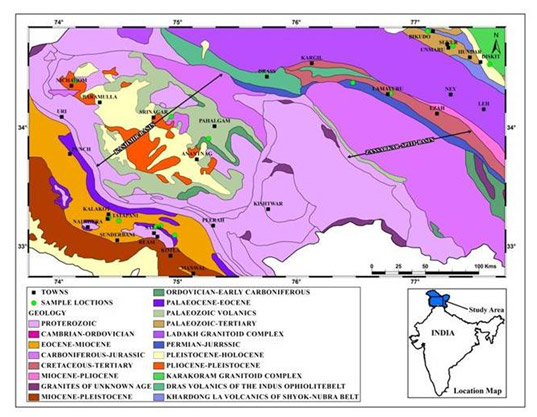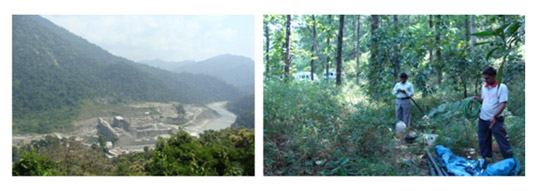Applied Science
| Title | Setting up of Rock Eval 6 Pyrolysis system |
|---|---|
| Participants | D. J. Patil, M.S. Kalpana , Devleena Mani, T. Madhavi, S. Kavitha, A M Dayal |
| Sponsoring Agency | Oil Industries Development Board |
Work Description:
Gas potentiality of the Proterozoic and Phanerozoic shales from the NW Himalaya, India: Inferences from new pyrolysis data
Information on the organic richness and kerogen properties of the shales from the North Western Himalayan region of India has been carried out for the evaluation of their gas generation potential. About seventy Proterozoic and Phanerozoic shales were sampled from the outcrops and underground mines of Jammu, Kashmir and Ladakh regions of Indian Himalaya (Fig11.1). The studied areas include the Cenozoic Foothills belt of Jammu and Intermontane basin of Kashmir which lie in the Outer Himalaya, the Zanskar basin that forms part of the Tethyan Himalaya, and the Ladakh and the Karakoram zones, containing Mesozoic-Tertiary shale forming part of the Trans Himalaya.
Ranging in age from Proterozoic to Tertiary, the organic matter characteristics of the carbonaceous and coaly shale rocks vary widely and exhibit significant controls of the sedimentary and burial history on the preservation and maturation of the organic component in rocks. The Upper Palaeocene to Eocene Subathu Group shales from the Jammu Foot Hill belts in the Outer Himalaya have high TOC content ranging (in wt. %) from 2% in carbonaceous shales to as high as 30% in coaly shales (Fig.11.2). These shales show S1 (thermally liberated free hydrocarbons) and S2 (hydrocarbons from cracking of kerogen) values between 0.1-2.6 mgHC/gRock (milligram hydrocarbon per gram of rock sample) and 0.5-15.5 mgHC/gRock,respectively. The Tmax (temperature at highest yield of S2) ranges between 490-515°C, suggesting a post mature stage for the hydrocarbon generation. The hydrogen index (HI) ranges between 10-113 mgHC/gTOC. The organic matter is characterized by gas prone Type III kerogen and fair to excellent source rock potential is exhibited by the Subathu shales.
The Interbedded shale units in the Proterozoic Sirban limestone Formation, which occurs as isolated inliers in Jammu, show a TOC nearing 1% with quite low HI values. The Plio-Pleistocene carbonaceous clays and lignites from Karewa Group are rich in organic matter with the TOC content up to 29.4%. The Tmax ranges between 399-427°C suggesting a mature phase for the hydrocarbons. The hydrogen index (HI) is comparatively high, ranging in values between 109-278 mgHC/gTOC. The shales from the Permian-Triassic boundary in Kashmir are lean in organic matter with TOC values of ≤1% whereas the Cretaceous shales from Ladakh show quite low TOC content of ≤0.5%. Majority of these shales from Tethys and Trans Himalayan region appear to have undergone organic metamorphism associated with the Himalayan orogeny.

Fig.11.1:
Geological map of Western Himalaya (after GSI, 2013) showing shale sample locations

Fig.11.2:
Source rock characteristics as interpreted by the relationship between hydrocarbon potential (S2) and TOC (wt. %) for the Subathu samples from Jammu Region